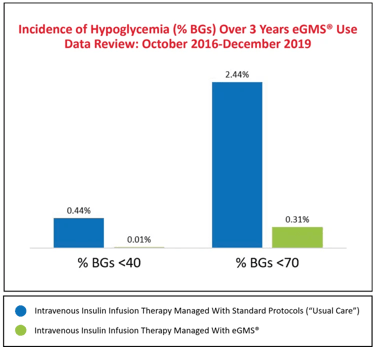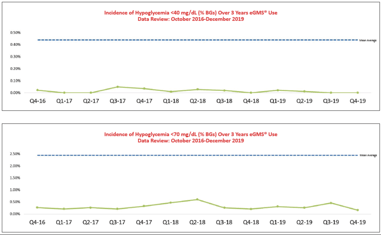Sustained Hypoglycemia Reduction Using eGlycemic Management System® to Manage Insulin Infusion Therapy Among Critical Care Patients
Presentation
Diabetes Technology Society (DTS) Virtual Poster Meeting
Date
June 18, 2020
Authors
Barbara McLean, MN, RN, CCNS-BC, NP-BC, Marina Rabinovich, PharmD, BCPS, Jordan Messler, MD, SFHM, FACP
OBJECTIVE
Identify whether reductions in hypoglycemia have been sustained among critical care patients receiving insulin infusion therapy managed using the technology-enabled eGlycemic Management System® (eGMS®).*
*eGlycemic Management System® is a registered trademark of Glytec, LLC on behalf of Aseko, Inc. All Rights Reserved.
METHOD
Grady Hospital, a 640-bed academic medical center in Atlanta, Georgia, conducted a retrospective review of critical care patients with persistent hyperglycemia >180 mg/dL who received insulin infusion therapy in an ICU (medical, surgical, cardiovascular neuroscience or burn) or step-down unit.
The primary endpoints were percentages of blood glucose readings (BGs) <40 mg/dL and <70 mg/dL. The review compares patients whose therapy was managed using eGMS® to those
whose therapy was managed using standard protocols (“usual care”). Data was collected for the period of October 2016 through December 2019. (NOTE: (eGMS® was implemented at Grady Hospital the month of December 2016).
This review is in follow up to a previous review in which data was collected for the period of October 2016 through December 2018. Usual care endpoints of 0.44% BGs <40 mg/dL and 2.44% BGs <70 mg/dL were carried forward from the previous review to this review.
RESULT
Reductions in hypoglycemia among critical care patients receiving insulin infusion therapy using eGMS® have been sustained over the three-year period since the system was implemented at Grady Hospital. The average percentage of BGs <40 mg/dL within the eGMS® population was .02% over the initial (previous) review period of October 2016 through December 2018 and was 0.01% over the (extended) follow-up review period of October 2016 through December 2019. This compares to a rate of 0.44% within the usual care population. The average percentage of BGs <70 mg/dL within the eGMS® population was 0.32% over the initial (previous) review period and was 0.31% over the (extended) follow-up review period. This compares to a rate of 2.44%
within the usual care population.
CONCLUSIONS
Reductions in hypoglycemia among critical care patients receiving insulin infusion therapy can be achieved and sustained effectively and efficiently using the technology-enabled eGlycemic Management System® (eGMS®), with 98% lower incidence of BGs <40 mg/dL when compared to usual care and 87% lower incidence of BGs <70 mg/dL.
References
- McLean B , Rabinovich M, Messler J. Sustained Hypoglycemia Reduction Using eGlycemic Management System® to Manage Insulin Infusion Therapy Among Critical Care Patients. DTS Virtual Poster Meeting. June 18, 2020.
ECO #0846-A

